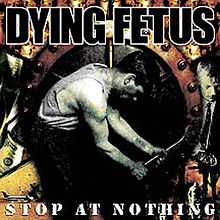| Professional ratings |
|---|
|
|
|
| Review scores |
| Source |
Rating |
| Allmusic |
     link link |
|
|
|
|
|
|
|
|
|
|
|
|
|
|
|
|
|
|
|
Stop at Nothing is the fourth album by the Maryland technical death metal band Dying Fetus. The album, like its predecessor, Destroy the Opposition, was produced by the band and Steve Carr.
Shortly after the release of Destroy the Opposition, all of the band except for John Gallagher quit. Gallagher brought in new vocalist Vince Matthews, guitarist Mike Kimball, bass guitarist Sean Beasley and drummer Eric Seyanga.
The black and white part of the cover of the album is part of a photograph taken by Lewis Wickes Hine, the American sociologist and photographer, called "Power house mechanic working on steam pump".[1] The steam pump has been shown in color while the original photo was completely black and white.
A video was produced for the song "One Shot, One Kill".
Two tracks form the album were used in Viva La Bam, "Schematics" in the second season episode "Tree Top Casino" and "Forced Elimination" in the third season episode "Angry Ape".[citation needed]
Track listing
All songs written and composed by John Gallagher
and Mike Kimball
, except where noted.
|
| 1. |
"Schematics" |
3:59 |
| 2. |
"One Shot, One Kill" |
4:25 |
| 3. |
"Institutions of Deceit" |
3:39 |
| 4. |
"Abandon All Hope" (Gary Dassing, Gallagher, Kimball) |
6:22 |
| 5. |
"Forced Elimination" |
3:22 |
| 6. |
"Stop at Nothing" |
3:09 |
| 7. |
"Onslaught of Malice" |
5:33 |
| 8. |
"Vengeance Unleashed" (Gallagher) |
5:08 |
Personnel
- Vince Matthews: vocals
- John Gallagher: guitars/vocals
- Mike Kimball: guitars
- Sean Beasley: bass guitar
- Erik Sayenga: drums
References
|
|---|
| | Studio albums | |
|---|
| | Compilation albums | |
|---|
| | EP's | |
|---|
| | Related articles | |
|---|
|
